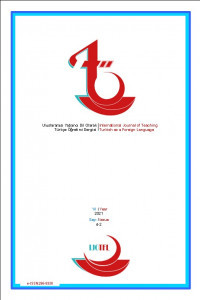Yabancı Dil Olarak Türkçe Öğretiminde Mikroagresyon
Edebiyat, Tarih, Sosyoloji, Halk Bilimi gibi birçok
bilim dalının ilgi alanına giren kültür kavramı en geniş tanımıyla bir milletin
maddi ve manevi değerler bütünüdür. Dil öğrenicisi yalnızca dil bilgisel
yapıları ya da sistemleri öğrenmez. Dil öğrenimiyle birlikte o dilin ait olduğu
kültürü ve değerler sistemini de özümsemeye başlar. Dil, bir göstergeler
sistemidir ve bu sistem kültürel unsurlarla örülüdür. Bu durum dilin iletişim
kurmayla beraber kültürel bakış açılarını yansıtan bir işlevini de beraberinde
getirmektedir. Yabancı dil olarak Türkçe öğretimi alanında genellikle dil
öğretim setlerinden yola çıkılarak çalışmalar yapılmış, bu çalışmalar
kitapların içinde hedef kültüre ait unsurların tespit edilmesi ve bu unsurların
sıklığı ile ilgili saptama ve öneriler şeklinde olmuştur. Ancak kültürel
anlamda iletişim sadece kitaplar vasıtasıyla gerçekleşmemektedir. Öğreticinin
sınıf içindeki davranışları, öğrenicilerle iletişim kurma yöntemleri, vücut
dilleri hatta ders işleme teknikleri olumlu ya da olumsuz mesajlar iletebilir.
Mikro agresif tutum olarak adlandırılabilecek bazı davranışlar olumsuz birtakım
sonuçlar doğurabilir. Bu durumlar dil öğrencisi üzerinde psikolojik baskı
oluşturabilir hatta hedef kültüre dair önyargılar gelişmesine zemin
hazırlayabilir. Tespiti zaman zaman güç olabilen bu tutumların öğreticinin
tecrübesi, bilinçli davranışları ve pedagojik muhakeme yeteneği ile önüne geçilebilir.
Böylece hem öğrenici motivasyonu sağlanır hem de doğabilecek olumsuz kültürel
aktarımın önüne geçilir.
Microagresion in Turkish Teaching as a Foreign Language
The concept of culture,
which belongs to many disciplines such as Literature, History, Sociology and
Folklore, is the most comprehensive definition of a nation's material and moral
values. The language learner does not only learn grammatical structures or
systems. Together with language learning, it begins to assimilate the culture
and values system of that language. Language is a system of indicators and this
system is built with cultural elements. This situation brings with it a
function which reflects the cultural perspectives of language along with
communication. In the field of teaching Turkish as a foreign language, studies
were generally conducted based on language teaching sets, and these studies
included the identification of the elements of the target culture in the books
and the frequency of these elements. In cultural terms, however, communication
is not carried out only through books. The behaviors of the instructor in the
classroom, the methods of communicating with the learners, body languages and
even lesson processing techniques can convey positive or negative messages.
Some behaviors that may be called as micro-aggressive attitudes may have
negative consequences. These situations may create psychological pressure on
the language student or even lead to the development of prejudices about the
target culture. These attitudes, which may be difficult to detect from time to
time, can be prevented by the teacher's experience, conscious behavior and
pedagogical reasoning ability. Thus, both the motivation of the learner and the
negative cultural transfer can be prevented.
___
- Byram, M. ve Carol M. (1994). Teaching-and-Learning Language-and-Culture. Clevedon: Multilingual Matters.
- Byram, M. vd. (2002) Developing the Intercultural Dimension in Language Teaching: A Practical Introduction for Teachers. Strasbourg: Council of Europe.
- Melanlıoğlu, D. (2013). Kültülerarsı İletişim Odaklı Yaklaşım, Yabancılara Türkçe Öğretimi El Kitabı, Editör: Musrafa Durmuş, Alpaslan Okur, Grafiker Yayınları, Ankara, sf. 129-135.
- Karasar, N. (2003). Bilimsel Araştırma Yöntemi. Ankara: Nobel Yayınları.
- Okur, Alpaslan ve Funda Keskin (2013). “Yabancılara Türkçe Öğretiminde Kültürel Öğelerin Aktarımı: İstanbul Yabancılar için Türkçe Öğretim Seti Örneği”. The Journal of Academic Social Science Studies 6(2): 1619-1640.
- Sue, D. W. (2010). Microaggressions, Marginality and Oppression. In D. W. Sue (Ed.). pp. 3-22. Microaggressions and Marginality. Hoboken, NJ: Wiley.
- http://www.jasstudies.com/Makaleler/1685982891_84OkurAlpaslan-KeskinFunda_S-1619-1640.pdf erişim: 15.10.2018.
